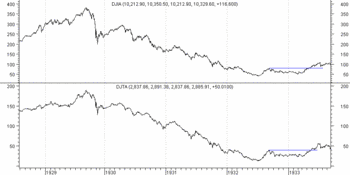Difference between revisions of "Stock market crash of 1929"
DavidB4-bot (Talk | contribs) (clean up) |
|||
| (6 intermediate revisions by 3 users not shown) | |||
| Line 2: | Line 2: | ||
In 1929 the [[Dow Jones Industrial Average]] (DJIA) declined 90.0% over a duration 34 months. Six successive market crashes comprised this famed crash: | In 1929 the [[Dow Jones Industrial Average]] (DJIA) declined 90.0% over a duration 34 months. Six successive market crashes comprised this famed crash: | ||
| − | + | #between September to November 1929 (the DJIA fell 40% in this first phase); | |
| − | + | #from April to June 1930; | |
| − | + | #from September to December 1930; | |
| − | + | #from March to May 1931; | |
| − | + | #from July to January 1932; | |
| − | + | #from March to July 1932. | |
A new upswing in DJIA stocks then started immediately, as did a general business recovery. | A new upswing in DJIA stocks then started immediately, as did a general business recovery. | ||
| + | [[File:Dow1925-2009.jpg|300px|thumb|Dow Jones index since 1925, in constant 2009 dollars]] | ||
| + | |||
| + | Business had topped out mildly, a month before the first crash; a gradual mild decline continued to April 1930, then fell sharply into a [[depression]] simultaneously with the end of the 1930 stock market rally. The business decline halted in December 1930, stayed level for 6 months, then plunged again in steep economic decline that didn’t lose its downward momentum for a full year, until July 1932. Business improved intermittently thereafter but still remained at depression levels through most of the decade of the 1930s except for a short recovery in 1936–37.<ref>Harry Schultz, ''Bear Market Investment Strategies'', Dow Jones-Irwin Co., 2002.</ref> | ||
| + | |||
| + | ==See also== | ||
| + | * Stock market crash of 1929 | ||
| + | * [[Great Depression]]: [[Depression]] | ||
| + | * [[Financial Crisis of 2008]] | ||
| + | * [[Recession of 2008]]: [[Recession]] | ||
| + | * [[American Recovery and Reinvestment Act of 2009]] | ||
| + | * [[Panic of 1907]] | ||
| + | * [[Panic of 1893]] | ||
| + | * [[Panic of 1837]] | ||
| + | * [[Financial crisis]] | ||
| + | * [[Economic collapse]] | ||
| + | * [[National debt]]: [[Federal Reserve System]]'s [[Ponzi scheme]] | ||
| + | * [[John Maynard Keynes]]' [[liberal]] [[Keynesian economics]] versus [[conservative]] [[libertarian]] [[Austrian economics]] | ||
| + | |||
| + | |||
| + | |||
| − | |||
==References== | ==References== | ||
<references/> | <references/> | ||
| − | [[Category: | + | {{Economic preparedness topics}} |
| + | [[Category:Economic Preparedness]] | ||
| + | [[Category:Threats]] | ||
| + | [[Category:Survivalism]] | ||
| + | [[Category:Economic History]] | ||
| + | [[Category:Finance]] | ||
| + | [[Category:1920s]] | ||
Latest revision as of 05:08, September 10, 2016
In 1929 the Dow Jones Industrial Average (DJIA) declined 90.0% over a duration 34 months. Six successive market crashes comprised this famed crash:
- between September to November 1929 (the DJIA fell 40% in this first phase);
- from April to June 1930;
- from September to December 1930;
- from March to May 1931;
- from July to January 1932;
- from March to July 1932.
A new upswing in DJIA stocks then started immediately, as did a general business recovery.
Business had topped out mildly, a month before the first crash; a gradual mild decline continued to April 1930, then fell sharply into a depression simultaneously with the end of the 1930 stock market rally. The business decline halted in December 1930, stayed level for 6 months, then plunged again in steep economic decline that didn’t lose its downward momentum for a full year, until July 1932. Business improved intermittently thereafter but still remained at depression levels through most of the decade of the 1930s except for a short recovery in 1936–37.[1]
See also
- Stock market crash of 1929
- Great Depression: Depression
- Financial Crisis of 2008
- Recession of 2008: Recession
- American Recovery and Reinvestment Act of 2009
- Panic of 1907
- Panic of 1893
- Panic of 1837
- Financial crisis
- Economic collapse
- National debt: Federal Reserve System's Ponzi scheme
- John Maynard Keynes' liberal Keynesian economics versus conservative libertarian Austrian economics
References
- ↑ Harry Schultz, Bear Market Investment Strategies, Dow Jones-Irwin Co., 2002.
| |||||||||||||||||


